1
Monday- Laundry
1920's
Saskatchewan, Canada
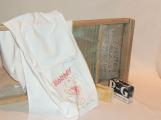 Credits:
Credits:
Assiniboia Museum
2
Monday was the logical day to do laundry because clothing was generally changed on Sunday, and with the leftovers from Sunday dinner no meal planning was necessary.
3
Coal and Wood Stove
1920's
Saskatchewan, Canada
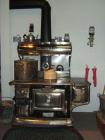 Credits:
Credits:
Assiniboia Museum
4
Very early on Monday mornings the housewife lit the fire in the coal and wood stove. Then the boiler that had been placed on stove Sunday night would be moved back over the fire box. She was preparing for a grueling day ahead after her daily chores.
5
Washstand
1920's
Saskatchewan, Canada
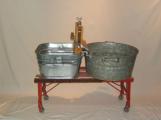 Credits:
Credits:
Assiniboia Museum
6
The washstand, wringer, and tubs were placed in the kitchen from its storage space. The cost of the tub was $1.25. The tub stand could be homemade. This is a commercial one that folded down.
7
Laundry Needs
Saskatchewan, Canada
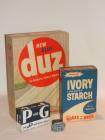 Credits:
Credits:
Assiniboia Museum
8
The shaved laundry bar soap had to be liquefied in a small crock over night after the boiling water had been poured over it - as seen in Chapter Eight. Later one could buy powdered soap. The small square package was 'bluing' that was used in the rinse water to brighten the white clothing.
9
Laundry Accessories
1920's
Saskatchewan, Canada
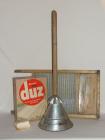 Credits:
Credits:
Assiniboia Museum
10
The water is now hot and the laundry begins. The water placed in one of the tubs, soap and white clothing are added. The hand plunger was used to force the hot water through the soiled clothing to release the dirt. This could take 10 minutes or so for each batch of clothing. This plunger was called "'the vacuum clothes washer' it compresses, forms strong suction forcing steam and suds through the clothes". Cost 98 cents.
11
Washboard
1920's
Saskatchewan, Canada
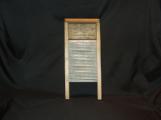 Credits:
Credits:
Assiniboia Museum
12
The very soiled clothing would be rubbed on the washboard. For extra soiled spots rubbing of the laundry bar soap could be used. Cost 45 cents.
13
Wringer
1920's
Saskatchewan, Canada
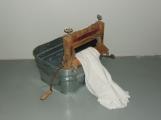 Credits:
Credits:
Assiniboia Museum
14
When clean, the clothing was put through the wringer, to remove as much of the soapy water as possible. The wrung articles were dropped into the second tub which contained the cool rinse water. The plunger was then used again to force the rinse water to remove the excess soapy water. The wringer could be moved to have the clean clothes drop into a basket. This continued until all the sudsy clothing went through this process. Cost wringer $6.25.